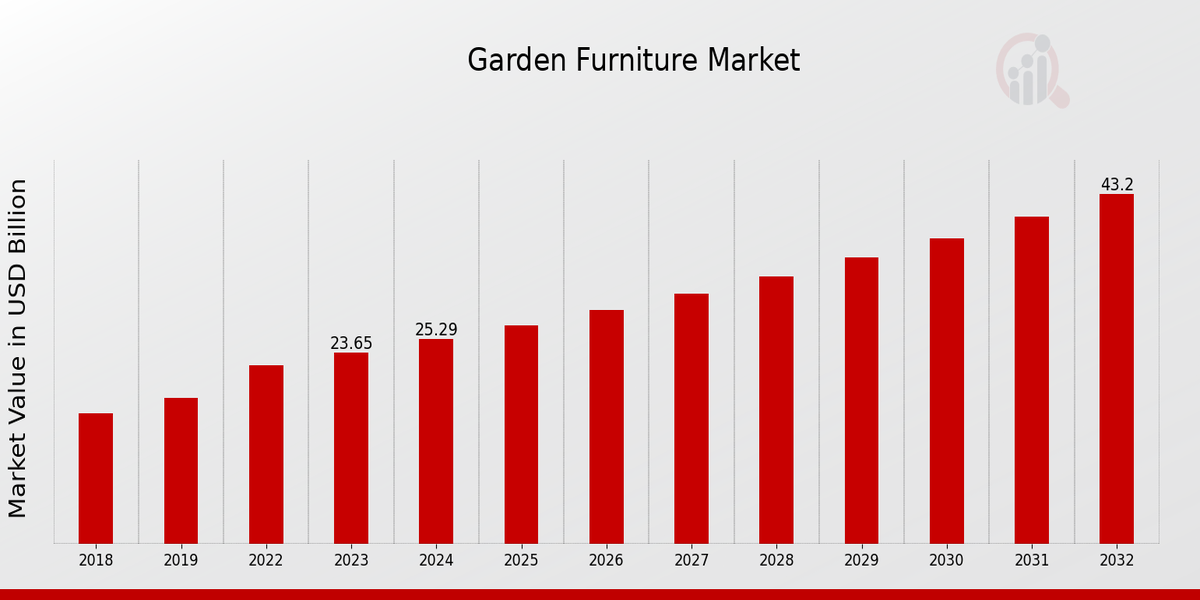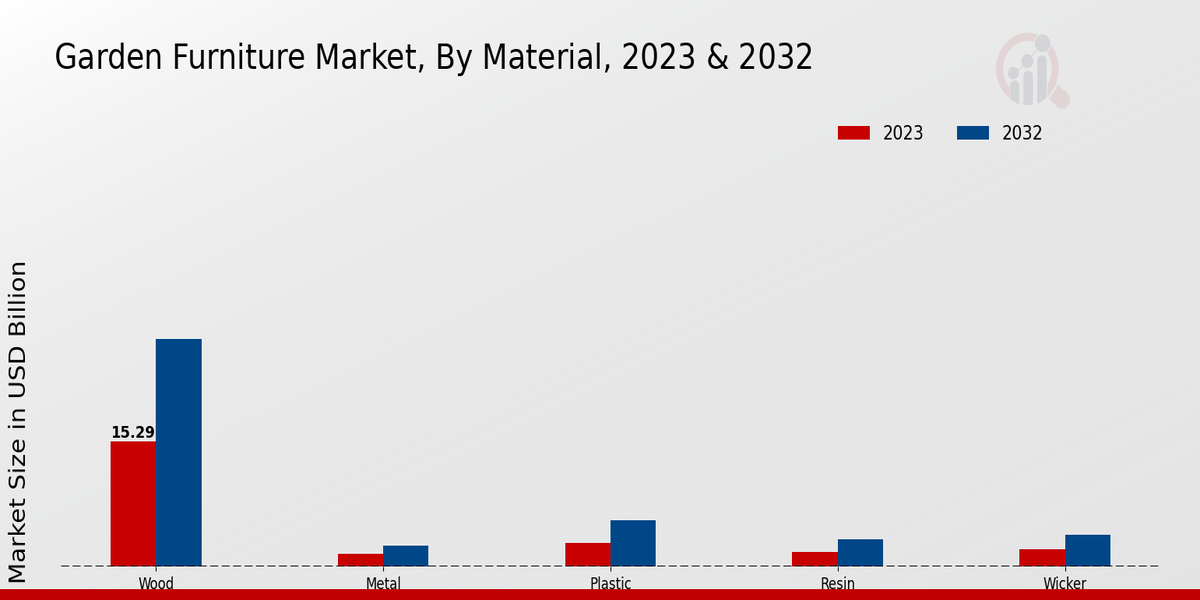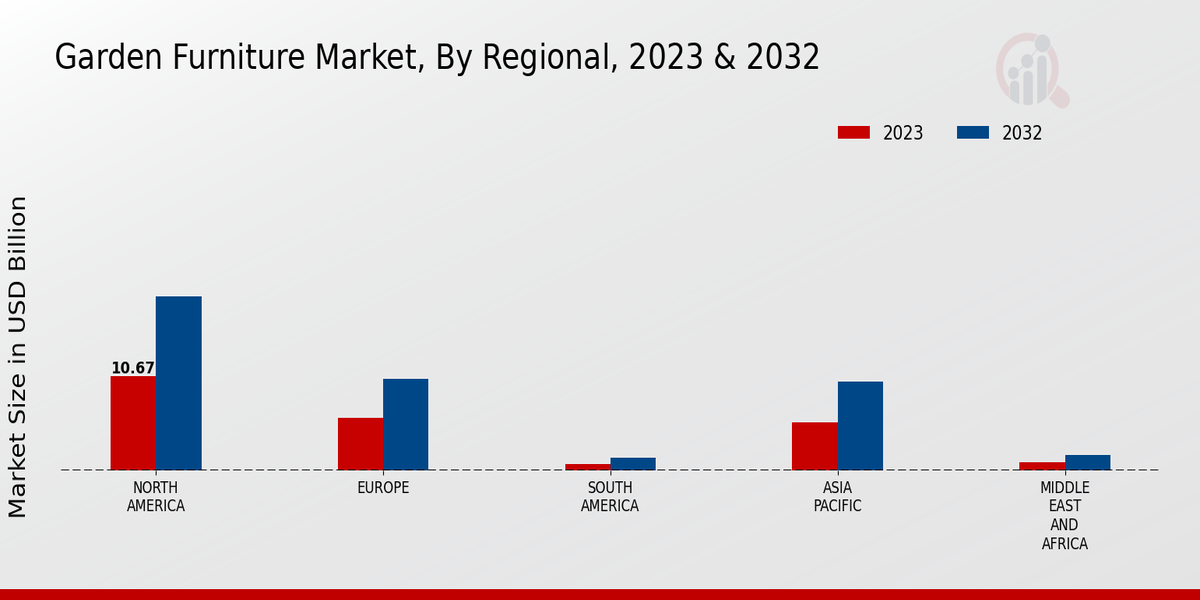Global Garden Furniture Market Overview
The Garden Furniture Market Size was estimated at 27.04(USD Billion) in 2024. The Garden Furniture Industry is expected to grow from 28.91(USD Billion) in 2025 to 52.8(USD Billion) by 2034. The Garden Furniture Market CAGR (growth rate) is expected to be around 6.90% during the forecast period (2025 - 2034).
Key Garden Furniture Market Trends Highlighted
Key market drivers for garden furniture include the growing trend of outdoor living, increasing disposable income, and urbanization. Consumers are looking for stylish and functional furniture that can enhance their outdoor spaces and create a comfortable and inviting atmosphere. The demand for sustainable and eco-friendly products is also on the rise, driven by consumer awareness of environmental issues.Opportunities to be explored include the development of innovative materials, such as weather-resistant fabrics and recyclable plastics, to meet the evolving needs of consumers. There is also scope for expanding into emerging markets, where demand for garden furniture is expected to grow significantly in the coming years. Additionally, collaborations with interior designers and landscape architects can open up new channels for product distribution and cater to the growing demand for customized outdoor solutions.Recent trends in the garden furniture market include the integration of technology, such as smart lighting and sound systems, into outdoor furniture. Additionally, there is a growing demand for modular and multifunctional furniture that can adapt to different spaces and needs. The use of natural materials, such as wood and wicker, remains popular, while the introduction of new colors and patterns adds a touch of style and personalization to outdoor spaces.

Source: Primary Research, Secondary Research, MRFR Database and Analyst Review
Garden Furniture Market Drivers
-
Growing Popularity of Outdoor Living Spaces
The increasing popularity of outdoor living spaces is a major driver of the growth of the garden furniture market. As people spend more time outdoors, they are looking for comfortable and stylish furniture to enhance their experience. Garden furniture provides a way to create a relaxing and inviting space to enjoy the outdoors, whether it's for dining, entertaining, or simply relaxing. The growing popularity of outdoor living spaces is expected to continue to drive demand for garden furniture in the coming years.
Increasing Urbanization and Limited Outdoor Space
The increasing urbanization and limited outdoor space in urban areas is another key driver of the growth of the garden furniture market. As more people move to cities, they are faced with smaller living spaces and less access to outdoor space. Garden furniture provides a way to create a private outdoor space, even in small urban areas. Balconies, patios, and rooftops are all becoming popular places to use garden furniture to create a relaxing and inviting outdoor space.
Rising Disposable Income and Consumer Spending
The garden furniture market is also growing due to the rising disposable income and consumer spending in developing countries. Disposable income and consumer spending are increasing in developing countries, as they have become a growing engine. As people have more money to spend, they want to improve their quality of their life. Garden furniture is becoming a popular product as people start to look for products that make their outdoor living spaces more comfortable and stylish.Increasing disposable income and consumer spending in developing countries will continue to drive the growth of the garden furniture market.
Garden Furniture Market Segment Insights
Garden Furniture Market Material Insights
The Garden Furniture Market segmentation by Material is a vibrant space. Wood, Metal, Plastic, Resin, and Wicker reign among the materials used in the industry, offering distinctive benefits for the customers and impacting the overall market growth to a great extent. Aesthetic superiority and unique natural appeal of wood account for a significant market share. Durability is another prominent feature supporting the choice of wood, as being resistant to mold and rotting and withering, this material is perfectly designed for prolonged outdoor use.The most popular wood types include teak, eucalyptus, acacia wood, as well as redwood and cedar to a lesser extent. Due to these unique characteristics, wood is popular due to its beautiful look and the ability to perfectly combine with outdoor environment. Metal is another material often used for garden furniture, with the most popular options being aluminum and wrought iron. The choice of metal is due to its durability, as this material is strong, which can make it last a lifetime. Both aluminum and iron will keep rust and corrosion away, perfectly fitting the outdoor furniture.Currently, the popularity of Plastic is rapidly growing, and the range of available options expands. This material is popular due to its low cost, low regard of color and shape, and high level of sustainability. Resin stands in-between wood and metal in terms of its characteristics: its use is popular due to weather-resistance, no fading, as well as resistance to mold, moisture, and pests. Wicker is made from the natural material made of rattan and willow, offering the unique outdoor feel. Natural texture and traditional weaving patterns make this type of furniture unique.The Garden Furniture Market revenue for the Material segment will amount to $12.5 billion by 2027, with a 5.9% annual growth rate.

Source: Primary Research, Secondary Research, MRFR Database and Analyst Review
Garden Furniture Market Product Type Insights
The Garden Furniture Market segmentation by product type includes lounge chairs and sofas, tables and chairs, benches, hammocks and swings, umbrellas and canopies. Among these, lounge chairs and sofas held the largest market share in 2023, accounting for over 30% of the revenue. The growing demand for comfortable and stylish outdoor seating options is driving the growth of this segment. Tables and chairs are expected to witness the fastest growth over the forecast period, due to the increasing popularity of outdoor dining and entertaining.Benches and hammocks and swings are also expected to experience steady growth, as consumers seek to create more inviting and functional outdoor spaces. Umbrellas and canopies are essential accessories for providing shade and protection from the elements, and this segment is expected to grow in line with the overall market.
Garden Furniture Market Distribution Channel Insights
The distribution channel segment plays a crucial role in the Garden Furniture Market. Online Retail is projected to witness a significant growth in the coming years, driven by the increasing penetration of e-commerce and the convenience it offers to customers. In 2023, the Online Retail segment accounted for around 25% of the Garden Furniture Market revenue and is expected to grow at a CAGR of 7.2% during the forecast period. Brick-and-Mortar Stores still hold a strong position in the market, particularly for high-end and luxury garden furniture.They offer customers the opportunity to physically inspect the products and receive personalized assistance, which is important for such purchases. In 2023, Brick-and-Mortar Stores accounted for around 40% of the Garden Furniture Market revenue and are projected to maintain a steady growth rate in the coming years. Home Improvement Centers are another important distribution channel for garden furniture, especially for DIY enthusiasts and homeowners looking for affordable and functional options. These stores offer a wide range of products and cater to the needs of both residential and commercial customers.In 2023, Home Improvement Centers accounted for around 15% of the Garden Furniture Market revenue and are expected to grow at a moderate pace in the future. Furniture Showrooms and Garden Centers also contribute to the distribution of garden furniture, targeting specific customer segments. Furniture Showrooms focus on high-end and designer garden furniture, while Garden Centers cater to gardening enthusiasts and offer a comprehensive selection of garden-related products, including furniture.
Garden Furniture Market End Consumer Insights
The end consumer segment of the Garden Furniture Market is segmented into residential, commercial, hospitality, and institutional. The residential segment is the largest segment, accounting for over 60% of the market share. The commercial segment is the second largest segment, followed by the hospitality and institutional segments. The residential segment is driven by the growing demand for outdoor living spaces and the increasing popularity of home improvement projects. The commercial segment is driven by the increasing number of hotels, restaurants, and other commercial establishments that are investing in outdoor furniture.The hospitality segment is driven by the growing number of tourists and the increasing demand for comfortable and stylish outdoor furniture in hotels and resorts. The institutional segment is driven by the increasing demand for outdoor furniture in schools, hospitals, and other public institutions.
Garden Furniture Market Regional Insights
North America is anticipated to spearhead the Garden Furniture Market revenue, in terms of growth rate over the forecast period backed by rising disposable income and consumer preferences for outdoor living spaces. Europe is also a key region, with a significant market share owing to the growing popularity of gardening and landscaping activities. APAC is expected to witness notable market growth, driven by the expanding middle class and increasing urbanization. South America and MEA represent emerging markets with considerable growth potential due to the rising adoption of outdoor furniture for both residential and commercial purposes.

Source: Primary Research, Secondary Research, MRFR Database and Analyst Review
Garden Furniture Market Key Players And Competitive Insights
Key players in the Garden Furniture Market industry are adopting various strategies to sustain their market position. Most notably, leading players in the Garden Furniture Market industry are concentrating on the production of new and innovative products in response to the changing tastes and preferences of consumers. Similarly, the producers are also investing in research and development of their offered product to further enhance the quality of their products. Further, the industry is also witnessing increasing collaboration of manufacturers and designers for the production of novel and stylish collections. For the long term, player’s strategies are majorly focused on expanding their businesses to newer market regions especially in emerging economies. The overall garden furniture competitive market will witness future developments by offering new opportunities for the key players in the market.Brown Jordan is the key web-based international vendor dealing with the production of luxury outdoor furniture. The company is widely known for its commitment to the production of high-quality products with design sophistication and timelessness feature. The offered types of selected outdoor fitness offered by the organization mainly include tables, sofas, chairs, and accessories. The major materials employed in the production of outdoor garden are aluminum, wicker, and teak. In addition, Brown Jordan is also concentrating on the provision of eco-friendly products through the use of environmentally safe materials. Brown Jordan has also been able to position itself as a market leader in the outdoor garden market segment due to its strong brands that are available in more than 42 strategic countries around the world. Being the major player in the outdoor furniture market, the company is able to employ cohesive designs in its sophisticated material applications for the provision of a modern touch.
Key Companies in the Garden Furniture Market Include
- Polywood
- Brown Jordan International
- Ashley Furniture Industries
- Lane Venture
- Castelle Furniture
- Hansgrohe SE
- Lloyd Flanders
- Tuuci
- Century Furniture
- Sunbrella
- Ratana Home Furnishings
- McGuire Furniture Company
- Gloster Furniture
- M Design
- Kettal
Garden Furniture Market Industry Developments
The rising popularity of outdoor living spaces and increasing disposable income are key drivers of market growth. Technological advancements, such as weather-resistant and sustainable materials, are further boosting demand. Key industry participants include Keter Group, Suncast Corporation, and Hartman USA. Recent news developments include the launch of eco-friendly furniture collections and strategic partnerships to expand market reach.
Garden Furniture Market Segmentation Insights
Garden Furniture Market Material Outlook
- Wood
- Metal
- Plastic
- Resin
- Wicker
Garden Furniture Market Product Type Outlook
- Lounge Chairs and Sofas
- Tables and Chairs
- Benches
- Hammocks and Swings
- Umbrellas and Canopies
Garden Furniture Market Distribution Channel Outlook
- Online Retail
- Brick-and-Mortar Stores
- Home Improvement Centers
- Furniture Showrooms
- Garden Centers
Garden Furniture Market End Consumer Outlook
- Residential
- Commercial
- Hospitality
- Institutional
Garden Furniture Market Regional Outlook
- North America
- Europe
- South America
- Asia Pacific
- Middle East and Africa
| Report Attribute/Metric |
Details |
| Market Size 2024 |
27.04(USD Billion) |
| Market Size 2025 |
28.91(USD Billion) |
| Market Size 2034 |
52.8(USD Billion) |
| Compound Annual Growth Rate (CAGR) |
6.90% (2025 - 2034) |
| Report Coverage |
Revenue Forecast, Competitive Landscape, Growth Factors, and Trends |
| Base Year |
2024 |
| Market Forecast Period |
2025 - 2034 |
| Historical Data |
2020 - 2024 |
| Market Forecast Units |
USD Billion |
| Key Companies Profiled |
Polywood ,Brown Jordan International ,Ashley Furniture Industries ,Lane Venture ,Castelle Furniture ,Hansgrohe SE ,Lloyd Flanders ,Tuuci ,Century Furniture ,Sunbrella ,Ratana Home Furnishings ,McGuire Furniture Company ,Gloster Furniture ,M Design ,Kettal |
| Segments Covered |
Material ,Product Type ,Distribution Channel ,End Consumer ,Regional |
| Key Market Opportunities |
Sustainabilityfocused products Outdoor living space expansion Smart garden furniture Luxury and premium furniture Multifunctional and spacesaving designs |
| Key Market Dynamics |
Growing demand for outdoor living spaces Sustainable materials becoming popular Technological advancements Ecommerce fueling market growth Personalized and innovative designs |
| Countries Covered |
North America, Europe, APAC, South America, MEA |
Frequently Asked Questions (FAQ) :
The garden furniture market size is valued at USD 28.91 billion in 2025 and is projected to reach a valuation of USD 52.8 billion by 2034, exhibiting a CAGR of 6.90% during the forecast period.
The growth of the garden furniture market is primarily attributed to factors such as the rising disposable income, increasing urbanization, and growing demand for outdoor living spaces. Additionally, the expanding hospitality sector and the growing popularity of staycations and outdoor gatherings are contributing to the market's expansion.
The Asia Pacific region is anticipated to dominate the garden furniture market throughout the forecast period. The region's growth is attributed to factors such as the expanding middle class, rising disposable income, and growing urbanization in countries like China, India, and Indonesia.
Garden furniture finds applications in both residential and commercial settings. In residential applications, it is used to enhance outdoor living spaces such as patios, decks, and gardens. In commercial applications, garden furniture is utilized in hotels, resorts, restaurants, and other outdoor hospitality venues.
Key competitors operating in the garden furniture market include Brown Jordan International, Inc., Keter Group, The Home Depot, Inc., Ashley Furniture Industries, Inc., and Target Corporation. These companies offer a diverse range of garden furniture products to meet the varying needs of consumers worldwide.
The garden furniture market faces certain challenges, including intense competition, seasonality, and weather conditions. Intense competition among manufacturers, particularly in the low-end segment, can impact profitability. Seasonality is a factor as demand for garden furniture tends to fluctuate based on weather conditions and time of year.
The garden furniture market exhibits promising growth potential, driven by the rising popularity of outdoor living and the increasing adoption of garden furniture in both residential and commercial settings. Growing disposable income and urbanization in emerging markets are expected to contribute to the market's expansion.
Some of the key trends observed in the garden furniture market include the growing adoption of sustainable and eco-friendly materials, the integration of smart technology, and the increasing demand for modular and multifunctional furniture. Consumers are becoming more environmentally conscious and seeking furniture made from recycled or sustainable materials.
The COVID-19 pandemic had a significant impact on the garden furniture market. During the initial stages of the pandemic, market growth slowed down due to lockdowns and disruptions in supply chains. However, as restrictions eased and people spent more time at home, demand for garden furniture gradually recovered.
Regulatory factors play a role in the garden furniture market, particularly in relation to safety and environmental standards. Regulations vary across different regions, and manufacturers must comply with applicable standards to ensure product safety and minimize environmental impact.

















